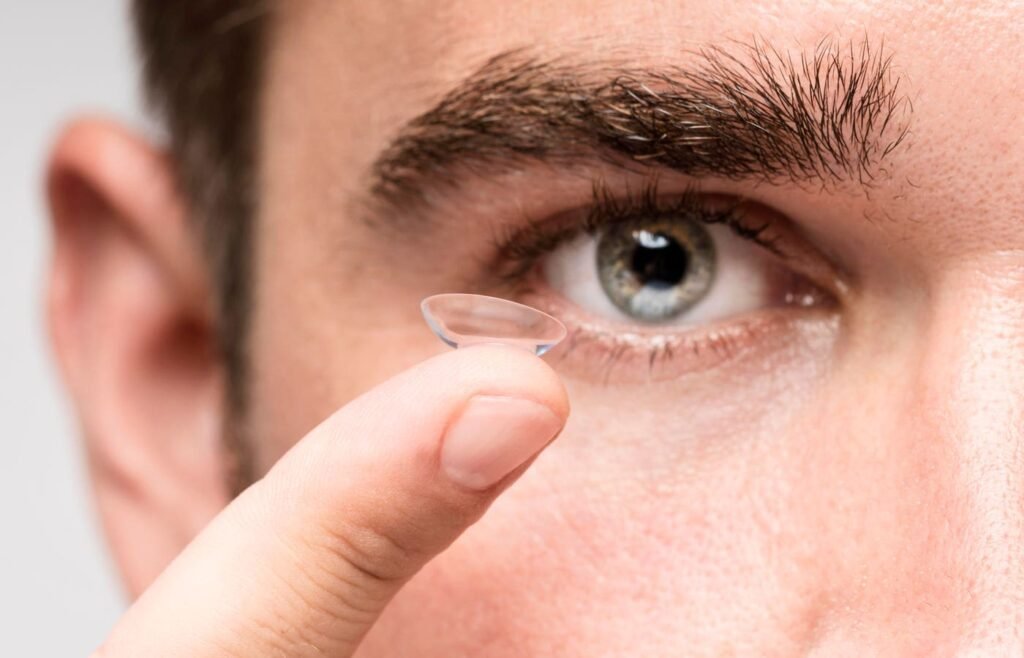Man with contact lenses
This story is part of a series on current developments in Regenerative Medicine. This piece is part of a series dedicated to the eye and improvements in vision rehabilitation.
In 1999, I defined regenerative medicine as the collection of interventions that restore tissues and organs damaged by disease, injured by trauma, or worn down by time to normal function. I include a full spectrum of chemical, gene, and protein-based drugs, cell-based therapies, and biomechanical interventions that achieve this goal.
Recently, the news about specialty glasses designed for people with color blindness has gathered the attention of people all over the world. For many, the ability to distinguish colors in everyday life is taken for granted. However, for people living with this condition, the impact can be debilitating, making it difficult to perform even the simplest tasks.
Color blindness is a common genetic disorder that affects a large portion of the population. It is estimated that around 8% of men and 0.5% of women worldwide have some form of color blindness. Despite its prevalence, there is still a lack of effective treatments for this condition.
However, with the advent of 3D printing technology, researchers and clinicians are developing new and innovative ways to address the needs of those with color blindness. This piece will explore how a 3D printed contact lens can help alleviate some of the symptoms associated with color blindness.
From current treatments to future vision
Current options for correcting lack of color are limited. One of the most popular types of color correcting lenses is offered by companies such as Enchroma. These lenses block specific wavelengths of light that interfere with the ability to differentiate between colors. While these lenses are effective for some people, they are not always successful for everyone. In addition, they are often expensive and can be difficult to obtain.
This is where 3D-printed contacts for color blindness come into play. Researchers from Khalifa University have developed a new technique that involves creating a contact lens with a unique design that can help correct color blindness. The lens filters out specific wavelengths of light to enhance the contrast between colors, just like eyeglass lenses work. This innovative approach has significant potential to change the lives of those with color blindness.
Creating 3D printed contacts
Creating contact lenses to correct color blindness is a complex and exciting process that requires specialized knowledge and skills. The first step involves using a 3D printer to create a mold of the contact lens. This mold is then filled with a technical organic material developed to correct different types of color blindness. The material is carefully selected based on its optical properties and ability to adhere to the mold surface.
a) Initially, contact lens molds are designed using computer-aided design (CAD) software. … [+]
The next step is to cure the material by exposing it to heat or UV radiation. The curing process ensures that the material retains its shape and properties and is firmly attached to the mold surface. Once the material has cured, the mold is removed, leaving behind a solid piece of color-correcting material in the shape of the contact lens.
The final step is to polish the lens to a smooth finish. This involves using specialized tools and techniques to remove any imperfections and create a lens surface that is perfectly smooth and transparent. This process is critical to ensure that the lens provides clear and accurate vision. The result is a specially designed contact lens adapted to the individual’s eyes.
The promise of 3D printed contacts for color blindness
Recent studies have shown promising results for 3D printed contact lenses as a solution for color blindness. A study from the Journal of Macromolecular Materials and Engineering was investigated using 3D-printed hydrogel contact lenses with integrated color-correcting dyes. The study found that the lenses effectively improved color vision in people with red-green color blindness.
Another study published in ACS Biomaterials Science & Engineering focused on developing tunable light filtering technology for 3D printed contact lenses. The study found that by incorporating pH-sensitive pigments into the lenses, the colors perceived by the wearer could be adjusted based on the pH level of their tears. This technology can potentially provide personalized color correction tailored to each individual’s needs.
However, it is important to note that these lenses are currently only adapted to certain types of color blindness. Therefore, people with different color deficiencies may not benefit from this technology. Furthermore, these lenses are still in the experimental stages and are not commercially available.
Despite these limitations, the potential for 3D-printed contacts to improve color perception in colorblind individuals is significant.
Vision of the future with 3D printed contacts
The development of 3D contacts for color blindness is a major milestone in personalized care. These contacts can potentially revolutionize the way we treat color blindness by offering a more effective and customized solution. For people with severe color blindness, the connections could offer a life-changing solution to significantly improve their quality of life. This is a step in the right direction. With further development and improvement, 3D printed contacts can become a widely accepted solution for color blindness.
To learn more about the eye, read more stories at www.williamhaseltine.com
